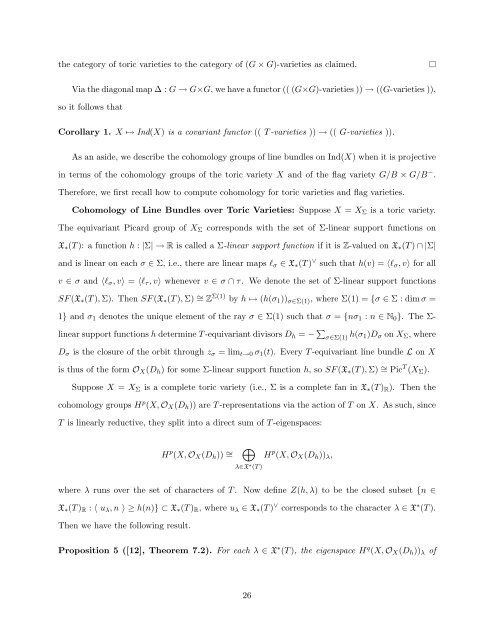Equivariant Embeddings of Algebraic Groups
Equivariant Embeddings of Algebraic Groups
Equivariant Embeddings of Algebraic Groups
Create successful ePaper yourself
Turn your PDF publications into a flip-book with our unique Google optimized e-Paper software.
the category <strong>of</strong> toric varieties to the category <strong>of</strong> (G × G)-varieties as claimed.<br />
Via the diagonal map ∆ : G → G×G, we have a functor (( (G×G)-varieties )) → ((G-varieties )),<br />
so it follows that<br />
Corollary 1. X ↦→ Ind(X) is a covariant functor (( T -varieties )) → (( G-varieties )).<br />
As an aside, we describe the cohomology groups <strong>of</strong> line bundles on Ind(X) when it is projective<br />
in terms <strong>of</strong> the cohomology groups <strong>of</strong> the toric variety X and <strong>of</strong> the flag variety G/B × G/B − .<br />
Therefore, we first recall how to compute cohomology for toric varieties and flag varieties.<br />
Cohomology <strong>of</strong> Line Bundles over Toric Varieties: Suppose X = X Σ is a toric variety.<br />
The equivariant Picard group <strong>of</strong> X Σ corresponds with the set <strong>of</strong> Σ-linear support functions on<br />
X ∗ (T ): a function h : |Σ| → R is called a Σ-linear support function if it is Z-valued on X ∗ (T ) ∩ |Σ|<br />
and is linear on each σ ∈ Σ, i.e., there are linear maps l σ ∈ X ∗ (T ) ∨ such that h(v) = 〈l σ , v〉 for all<br />
v ∈ σ and 〈l σ , v〉 = 〈l τ , v〉 whenever v ∈ σ ∩ τ. We denote the set <strong>of</strong> Σ-linear support functions<br />
SF (X ∗ (T ), Σ). Then SF (X ∗ (T ), Σ) ∼ = Z Σ(1) by h ↦→ (h(σ 1 )) σ∈Σ(1) , where Σ(1) = {σ ∈ Σ : dim σ =<br />
1} and σ 1 denotes the unique element <strong>of</strong> the ray σ ∈ Σ(1) such that σ = {nσ 1 : n ∈ N 0 }. The Σ-<br />
linear support functions h determine T -equivariant divisors D h = − ∑ σ∈Σ(1) h(σ 1)D σ on X Σ , where<br />
D σ is the closure <strong>of</strong> the orbit through z σ = lim t→0 σ 1 (t). Every T -equivariant line bundle L on X<br />
is thus <strong>of</strong> the form O X (D h ) for some Σ-linear support function h, so SF (X ∗ (T ), Σ) ∼ = Pic T (X Σ ).<br />
Suppose X = X Σ is a complete toric variety (i.e., Σ is a complete fan in X ∗ (T ) R ). Then the<br />
cohomology groups H p (X, O X (D h )) are T -representations via the action <strong>of</strong> T on X. As such, since<br />
T is linearly reductive, they split into a direct sum <strong>of</strong> T -eigenspaces:<br />
H p (X, O X (D h )) ∼ =<br />
⊕<br />
H p (X, O X (D h )) λ ,<br />
λ∈X ∗ (T )<br />
where λ runs over the set <strong>of</strong> characters <strong>of</strong> T . Now define Z(h, λ) to be the closed subset {n ∈<br />
X ∗ (T ) R : 〈 u λ , n 〉 ≥ h(n)} ⊂ X ∗ (T ) R , where u λ ∈ X ∗ (T ) ∨ corresponds to the character λ ∈ X ∗ (T ).<br />
Then we have the following result.<br />
Proposition 5 ([12], Theorem 7.2). For each λ ∈ X ∗ (T ), the eigenspace H q (X, O X (D h )) λ <strong>of</strong><br />
26
















